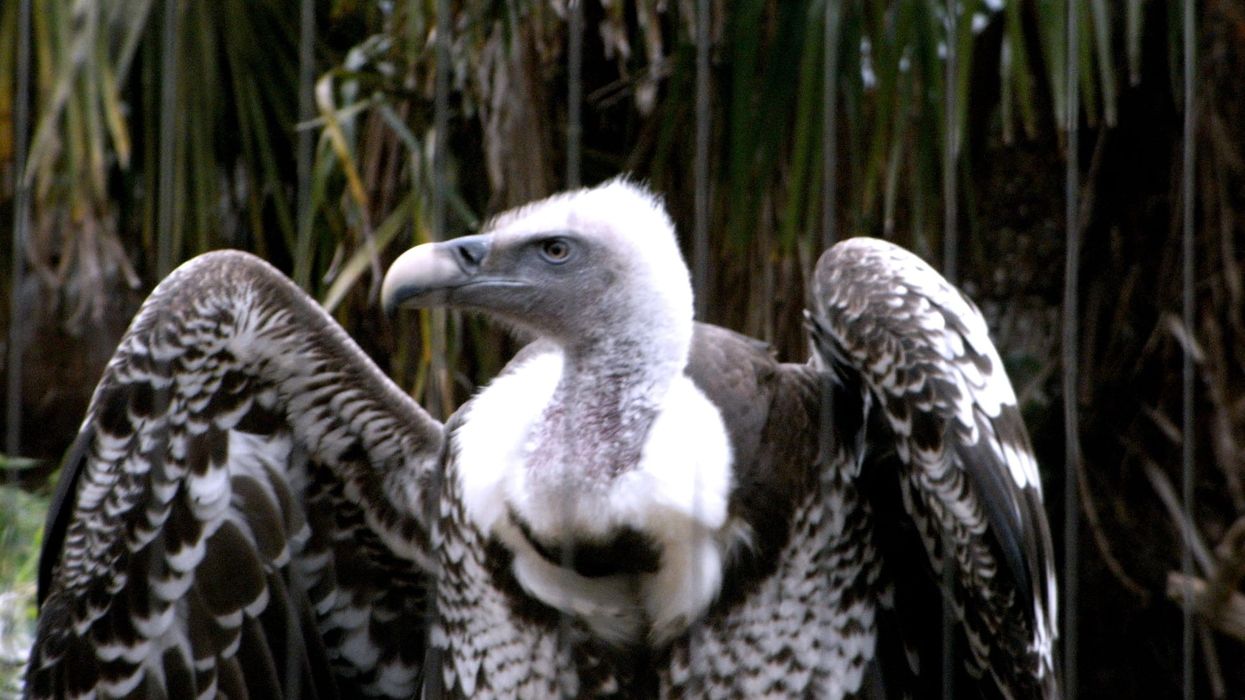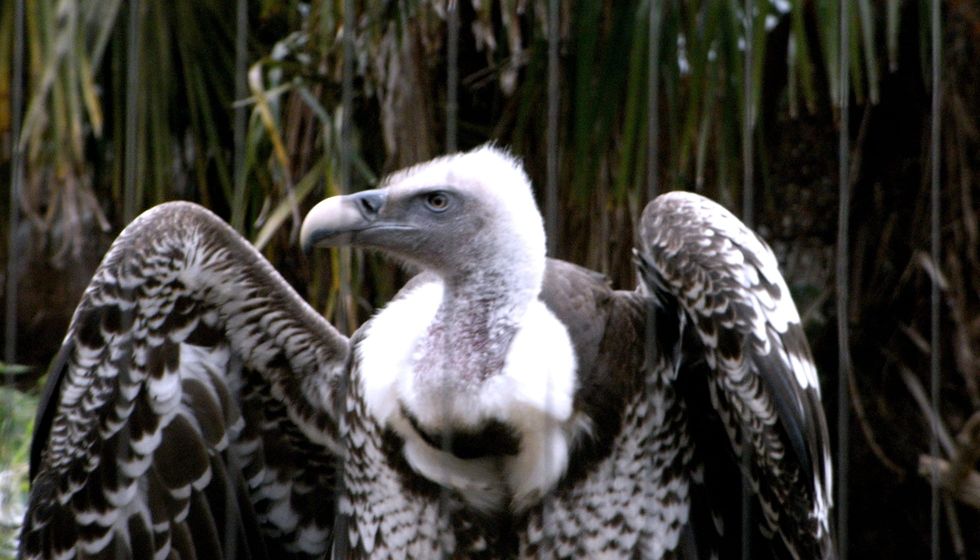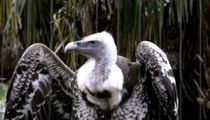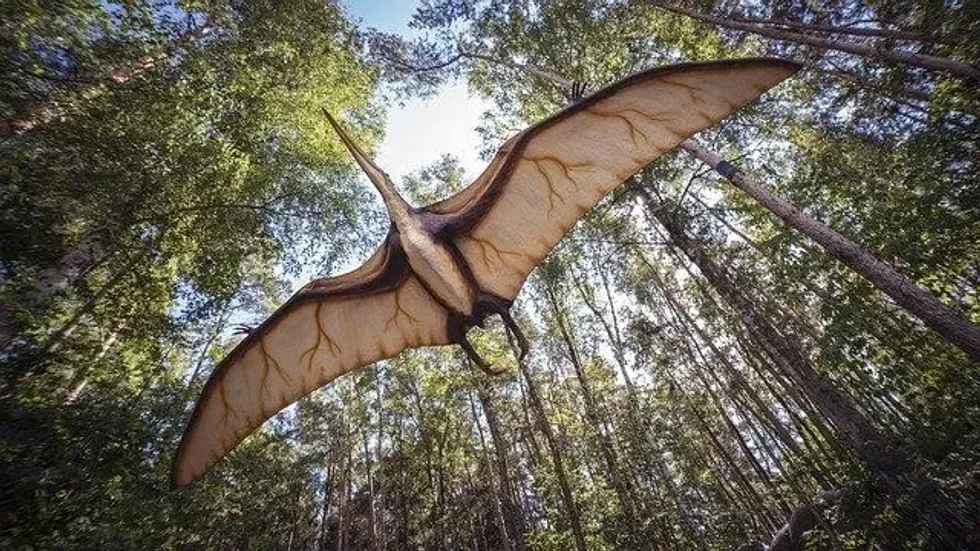Did you know that vultures symbolize death or back luck? It is an omen that is believed in some places of the world.
Ruppell's vultures also known as Rüppell's griffon vultures are related to scavengers as they feed on carcasses of the dead animals.
They have brown or black plumage, with a white collar at the base of the neck, a bald head, and strong feet. These birds are distributed in the sub-arid woodlands and mountain regions of central Africa in Sudan, Nigeria, Ethiopia, and some parts of east Africa.
The Ruppells vulture flight has a considerably slow speed, but they usually fly at high altitudes for long hours, almost 20,000 ft (6000 m) above sea level.
These birds have an excellent sense of vision and smell as they can sense the dead from afar and also have social nature as they feed, nest and roost together in large flocks.
The vultures play an important role as they feed on the dead and prevent spreading germs from the rotting bodies.
The bird species is red-listed by IUCN and their population is in reducing. They are considered the highest-flying bird species.
Learn more about other amazing bird facts, such as saker falcon bird facts and red-tailed hawk facts.
Ruppell's Vulture Interesting Facts
What type of animal is a Ruppell's vulture?
A Ruppell's vulture, Gyps rueppelli, is a scavenger that feeds on the carcasses of dead animals and can fly at high altitudes. The Ruppell's vulture is named after Edmund Ruppell, a German naturalist, zoologist, and explorer.
What class of animal does a Ruppell's vulture belong to?
A Ruppell's vulture belongs to the class of Aves and the family of Accipitridae. These birds are also known as Ruppell's griffon vulture or Rüppell's griffon.
How many Ruppell's vultures are there in the world?
The IUCN reports that there are currently 22,000 Ruppell's griffon vultures in the world and their number is gradually decreasing due to a decline in natural habitat, food poisoning, and reduced reproduction rate.
Where does a Ruppell's vulture live?
The Ruppell's vulture range is in the Sahel region central Africa consisting of Sudan, Ethiopia, Senegal, Gambia, and Mali in the western region. This species is also found in East Africa.
What is a Ruppell's vulture's habitat?
The Ruppells vulture native habitat includes the open sub-arid grasslands, woodlands, and the mountain range of central Africa. They construct their nest on mountain cliffs.
Who do Ruppell's vultures live with?
The Ruppell's griffon vultures are considered social birds because they form large flocks to search for food, nesting, and also roosting together. The vultures from pairs and many pairs combine to make large colonies, thus other species of birds do not mingle usually with them.
How long does a Ruppell's vulture live?
An African Ruppell's vulture has a life span of 40-50 years.
How do they reproduce?
The Ruppell's griffon vulture forms breeding colonies consisting of many breeding pairs.
The pairs of these vultures build large nests on cliffs, mostly using sticks, and covers them with grass and leaves.
After the nesting is ready, the Ruppells vulture female bird lays a single egg, then the incubation period is approximately 55 days in which both parents take care of the egg, as well as upon hatching they take care of the chick until it grows 150 days old, and leaves the nest.
The chick learns to find food from their parents and become independent in the following breeding season.
What is their conservation status?
Ruppell's vulture's conservation state is reported as Critically Endangered and is included in the IUCN Red List. There are approximately 22,000 of these vultures all over the world and they are also preserved at some zoos as their number is in decline.
Ruppell's Vulture Fun Facts
What do Ruppell's vultures look like?

Ruppell's griffons, or Rüppell's vultures, have a deep brown or black plumage with hunched, pale-colored fluff covering the head and neck and their underparts are pale brown. There is a white-collar at the base of their neck and yellow or amber-colored eyes, having great eyesight to search for carcasses.
Their head does not have any feathers, they have droopy throats, and strong feet and beaks.
The males and females look alike. Vultures have long wings which protect them from the cold nights in arid grasslands and also help them to reach high altitudes or travel long distances in flight.
How cute are they?
These vultures with big wings, bald heads, and droopy throats, are not cute at all! The baby vulture bird in its early days can be considered cute though.
How do they communicate?
Ruppell's griffon vultures are mostly silent birds, but they have squealing or barking sounds or chatters when they fly at high altitudes and find food or when they roost. They also communicate using visual cues.
How big is a Ruppell's vulture?
A Ruppell's vulture is almost 33.5- 40.5 in (85-103 cm) in length. These birds have a wingspan of 7.4-8.5 ft (2.3-2.6 m) in length.
How fast can a Ruppell's vulture fly?
Ruppell's vultures fly at a moderately slow speed, traveling at a speed of 22 mph (35 kph) in flight. They can fly for six-seven hours regularly and can cover large distances from their nest to find food.
How much does a Ruppell's vulture weigh?
A Ruppell's griffon is on average 14-20 lb (6.4-9 kg). Their large wings and feet increase their bodyweight.
What are the male and female names of the species?
There are no names assigned to the male and female Ruppell's vultures.
What would you call a baby Ruppell's vulture?
A baby Ruppell's vulture is called a chick.
What do they eat?
The Ruppell's vulture's diet includes the carcass of dead animals like antelopes or striped hyenas and rarely do they prey on small sand lizards, black rats, or other birds. Once a carcass is spotted, a large flock of vultures surround it and feed using their powerful beak. Their main predators are humans.
Are they dangerous?
No, Ruppell's vultures, despite being carnivores, are not dangerous to humans.
Would they make a good pet?
Having a vulture as a pet bird in the home environment is unimaginable. Although, since this species is near threatened, thus they are preserved in small flocks in some zoos, where they are provided with artificial habitats.
Did you know...
The Ruppell's griffon vulture's highest altitude above sea level was 37,000 ft (11,300 m), recorded on 29 November 1973, when a Ruppell's vulture was killed by the jet of an airplane flying over Abidjan, Ivory Coast, thus they are recognized as the highest-flying bird.
Ruppell's vultures belong to the group of eight species having long necks and a bald head.
The absence of neck feathers allows the vulture to reach dig deep into a carcass without getting dirty.
Why do Ruppell's vultures fly so high?
Ruppell's griffon vultures soar high in the sky in search of food. Some may consider them as lazy birds as they don't hunt but, they regularly fly for many hours and cover long distances.
Why are Ruppell's vultures endangered?
The Ruppell's griffon vulture species have suffered a rapid fall in their population mostly in West Africa. They are Critically Endangered at present due to the result of agriculture on their natural environment and killed by large-scale accidental poisoning. They are also used for black magic practices in some parts of Africa.
Here at Kidadl, we have carefully created lots of interesting family-friendly animal facts for everyone to discover! Learn more about some other birds from our griffon vulture facts and Andean condor facts pages.
You can even occupy yourself at home by coloring in one of our free printable Ruppell's vulture bird coloring pages.
Second image by Mark Fisher.










